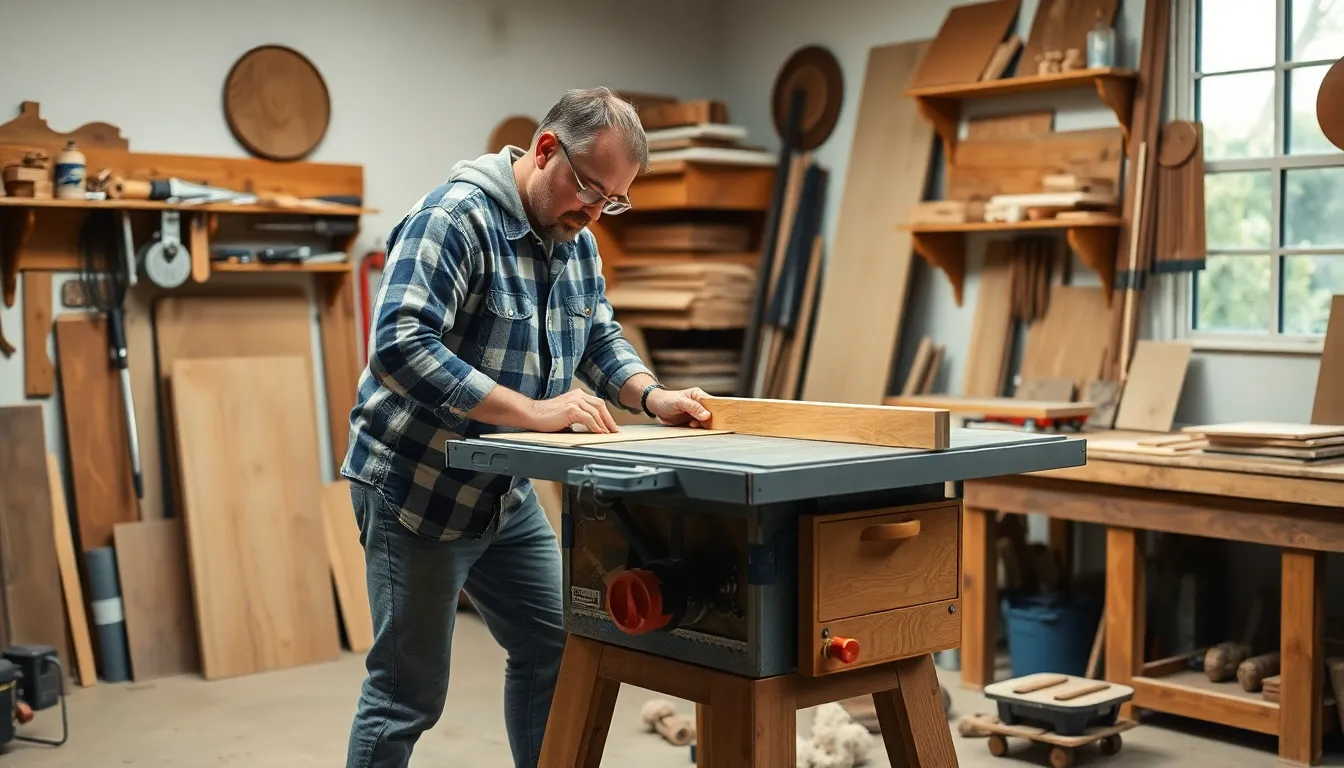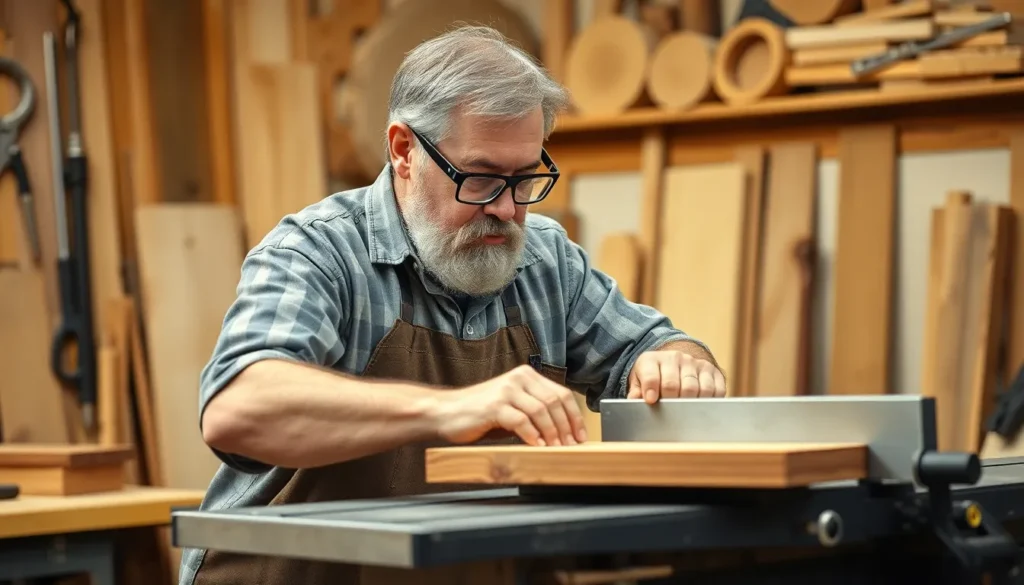In the world of woodworking, having the right tools can make all the difference between a masterpiece and a pile of kindling. When it comes to table saws, the stakes are high. A great table saw doesn’t just slice through wood; it transforms raw materials into stunning creations. But with so many options out there, how does one choose the best table saw without losing their sanity—or their fingers?
Best Table Saw for Woodworking
Table saws come in various types, each designed for specific woodworking needs. Understanding their features can help identify the best option for any project.
Cabinet Table Saws
Cabinet table saws excel in stability and precision. They feature a robust construction that minimizes vibration, enabling clean cuts for intricate projects. With a powerful motor, these saws handle dense hardwoods effortlessly. Many professional woodworkers favor cabinet models due to their superior accuracy and extended cutting capacities. Additionally, an enclosed cabinet design improves dust collection, enhancing the overall work environment.
Contractor Table Saws
Contractor table saws provide a balance of portability and performance. Typically lighter than cabinet models, these saws facilitate easy transportation between job sites. They deliver sufficient power for most home projects and hobbyist needs, often equipped with a versatile fence system for precise adjustments. While not as heavy-duty, contractor saws cater well to those requiring a dependable tool without investing in a larger model.
Portable Table Saws
Portable table saws offer exceptional convenience for on-the-go projects. Lightweight and compact, these saws set up quickly and store easily when not in use. Many models include folding stands that enhance their mobility. Despite their size, portable saws can handle various materials, making them suitable for both amateurs and professionals alike. Features like adjustable fences assist in making accurate cuts without compromising portability.
Key Features To Consider

Selecting the best table saw for woodworking involves evaluating several essential features. Focus on these factors to ensure optimal performance and satisfaction.
Motor Power
Motor power significantly influences the cutting capabilities of a table saw. Generally, a motor rating of 1.5 to 3 horsepower suits most woodworking tasks. Higher horsepower enables the saw to tackle dense materials like hardwood without straining. Careful consideration of motor speed is critical since this determines how quickly the blade spins. Faster speeds lead to cleaner cuts, reducing splintering. Some users prefer higher motor power for professional applications where precision and efficiency matter greatly.
Blade Quality
Blade quality directly impacts the quality and accuracy of cuts. A high-quality blade crafted from durable materials enhances longevity and performance. Carbide-tipped blades offer excellent resistance to wear and maintain sharpness longer. Size matters, with common options ranging from 10 to 12 inches. A larger blade accommodates thicker material, while a smaller blade offers better maneuverability. Understanding the tooth design is essential, as different configurations serve various cutting tasks, such as ripping or crosscutting.
Safety Features
Safety features play a critical role in woodworking, ensuring user protection during operation. Look for saws equipped with blade guards that effectively shield operators from accidental contact. Anti-kickback pawls help prevent material from being thrown back during cuts, reducing injury risks. Many modern table saws incorporate electric brakes, stopping the blade almost instantly when necessary. Additional features like blade riving knives provide extra safety during cuts, maintaining alignment and minimizing binding. Prioritizing these safety attributes enhances user confidence and promotes a secure working environment.
Top Recommendations
Choosing the right table saw can make all the difference in woodworking projects. Here are some top recommendations across different categories.
Best Cabinet Table Saw
The SawStop PCS31230-TGP252 stands out in the cabinet table saw category. This model features a 3 horsepower motor, providing exceptional cutting power for various hardwoods. With its precision grouped with safety technology, it integrates a patented flesh detection system that stops the blade upon contact with skin. Superior fence systems ensure accurate cuts each time. Its robust construction and large table size offer stability, making it ideal for professional woodworkers.
Best Contractor Table Saw
For contractor table saws, the DeWalt DWE7491RS impresses with its portability and performance. It sports a 10-inch blade and a powerful 15 amp motor capable of ripping through tough lumber. This model includes a rolling stand, allowing easy setup and transport, making it perfect for on-site projects. An innovative rack and pinion fence system enhances precision and ease of use. This versatility caters well to both hobbyists and serious woodworkers.
Best Portable Table Saw
The Bosch 4100-10 is a prime choice for portable table saws. Weighing only 60 pounds, this model is easy to move and setup. Its 10-inch blade, aided by a 15 amp motor, delivers powerful cutting capabilities, while an integrated wheeled stand adds convenience. Safety features like a blade guard and anti-kickback pawls protect users during operation. With compact size and robust performance, it excels in various woodworking scenarios, especially for those needing mobility.
Maintenance Tips
Maintaining a table saw ensures safety and performance. Regular upkeep extends the life of the tool and enhances cutting precision.
Regular Cleaning
Cleaning a table saw regularly prevents dust and debris accumulation. Use a soft brush and a vacuum to clear the surface and the internal components. Inspect the the table surface often, as scratches can affect accuracy during cuts. Wipe down the blade with a cloth soaked in mineral spirits to remove pitch and resin. This practice maintains blade effectiveness and ensures cleaner cuts. Keeping the blade and table free from contaminants enhances performance and promotes safety during operation.
Blade Replacement
Changing the blade on a table saw impacts cut quality directly. Replace the blade whenever it shows signs of dullness or damage. Common indicators include splintering or burning on the edges of the cut material. Consider using a carbide-tipped blade for longer-lasting performance. Check the manufacturer’s recommendations regarding appropriate blade types and sizes for optimal results. Timely blade replacement guarantees smoother cuts and increased efficiency in woodworking projects.
Conclusion
Choosing the right table saw can significantly impact any woodworking project. Whether it’s a cabinet saw for professional use or a portable option for hobbyists each type offers unique advantages that cater to different needs. Prioritizing features like motor power blade quality and safety mechanisms ensures a safe and effective woodworking experience.
Regular maintenance is just as crucial for optimal performance. Keeping the saw clean and replacing blades when necessary can enhance accuracy and prolong the tool’s lifespan. With the right table saw and proper care woodworkers can transform their ideas into stunning creations with confidence and precision.

